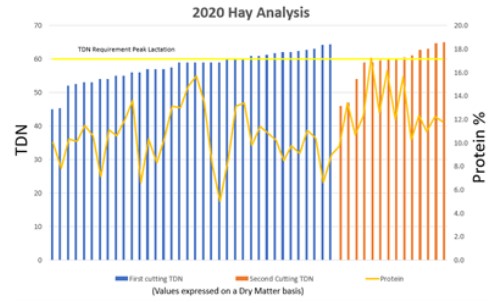By Ted Wiseman
We can certainly say this past year has had its challenges. However, quality of forages made in 2020 was much better for most compared to the previous two years. Weather conditions were more favorable especially for first cutting. The late frost in May set our forages back and for many first cutting forage yields were extremely low. Second, third and four cuttings were better, but overall hay supplies are tight again for some.
Again in 2020 Extension Educators in 10 counties have collected forage samples from across the state. Chart 1 is data collected in 2019. I know we would like to forget the condition of forages in 2019, but I have included it for comparison to forage quality in chart 2 for 2020. To clarify most of these samples are not from the same producer or the same fields. This demonstration is to make a simple comparison of the overall quality of random forage samples.
Percent TDN (total digestible nutrients) is a measure of the amount of energy in the feed. Basically, this equates to the number of calories. Percent protein shown as the yellow horizontal line is a measure of the protein that is available to the animal for maintaining muscle and body systems. It is also very important for development of the calf she is carrying. In both charts the vertical blue bars represent 1st cutting hay samples while the vertical orange bars represent 2nd cutting.

For a 1200-pound cow, a TDN level of 60% is needed for a cow in peak lactation, 54% at calving, and 49% for the last trimester. The corresponding protein levels for each of these times would be 8, 10 and 11 percent, respectively. Looking at the charts you will notice that in 2019 we certainly had some issues with meeting cattle TDN requirements with first cutting hay. Although many would have been adequate for the last trimester and at calving. In 2020 samples tended to be much better and would have met their nutritional needs for most.
However, for both years some samples still fall short of having high enough levels of energy or protein for the 3 stages of pregnancy in this example. It is also notable that higher TDN levels do not translate into higher protein levels regardless of what time of year the forage was harvested.
No matter how good or bad of a forage harvest season we have. It is extremely beneficial for producers to collect forage samples. Regardless of what specie of livestock you have, knowing what the quality of forage you are feeding is well worth the costs of the sample.
Source : osu.edu